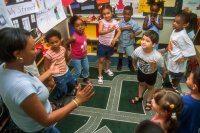How Teachers Can Ease the Transition to Kindergarten
Three strategies early childhood educators can use to help prepare their students for the changes ahead.
Your content has been saved!
Go to My Saved Content.As we sit around the snack table, I share with my soon-to-be kindergarten students that they will have a new teacher next year and will make lots of new friends. Some of them are excited, but Peter says, “No, Ms. Maddi, you’re going to be my teacher next year!”
Even though I would love to keep Peter and his sweet, outgoing self in my class next year, he is ready for the new challenges that await him in kindergarten. I have the privilege of working with my students for two to three years in my early childhood special education class, and I witness incredible growth and learning. I love being a part of their first experience with school, but eventually they need to move on.
I take my responsibility to prepare them for the high expectations of kindergarten very seriously, while still maintaining developmentally appropriate practices in my classroom. I ask my students questions to promote higher-level thinking, incorporate play and hands-on experiences, and encourage persistence and effort when tasks are new or difficult. This can be challenging; changes to curriculum over the last few years, including those mandated by the Common Core State Standards, have gradually made elementary school more academically rigorous than ever before.
There are some factors not fully in our control—such as developmental delays, maturity levels, and parental involvement—that can hinder a student’s ability to fully access the fast-paced, academically demanding environment of kindergarten. However, there are many actions that we early childhood teachers can take to help our students prepare for the transition. Here are three that I have found effective.
Communicate
Start with a simple conversation with your local school district’s kindergarten teachers. In order to begin laying the foundation for kindergarten learning, early childhood teachers need to know kindergarten teachers’ expectations and be familiar with the scope and sequence of the curriculum.
Ideally, this should be more than a single conversation. I recommend that kindergarten and early childhood teachers meet at least once a year, with several goals: aligning their expectations and routines, increasing consistency of experiences for students, understanding each other’s practices, and becoming partners and allies.
Observe
I am fortunate to work in an elementary school building and to have frequent communication with the kindergarten teachers. When we meet during professional learning community meetings, I can talk with them about their quarterly assessments, review assessment data, and learn about the structures and routines of their classrooms. I have also observed several of their classrooms during academic instruction and center time, when the students are engaged in hands-on learning.
All of this information helps me better understand what I can be doing to help each of my students; it also gives me an idea of the types of materials, activities, and skills they will be learning once they get to kindergarten.
For early childhood teachers in non-school-based settings (such as child-care centers or in-home child care), setting up observations can be challenging; however, doing so is worth it, since seeing kindergarten classrooms benefits both the teachers and transitioning students. Additionally, it’s helpful for kindergarten teachers to observe early childhood classrooms to become familiar with the environment and expectations their incoming students are coming from.
Modify
After observing in the kindergarten classrooms, I always come away with new ideas to incorporate into my own classroom. For example, after seeing a Jolly Phonics lesson in kindergarten, I decided that I’d like to incorporate actions and visuals for each letter sound into my daily calendar time. This way, my students will have some background knowledge when they get to kindergarten.
In another observation, I noted that the kindergarten math curriculum uses 10 frames (rectangles made up of 10 smaller squares). Now I introduce those to my students as we work on counting and developing one-to-one correspondence skills. While I introduce these materials to my students to familiarize them with what they will see in kindergarten, I also make sure that the use of these materials in my classroom is developmentally appropriate.
The transition from preschool to kindergarten can be intimidating and scary for both parents and children. As early childhood teachers and providers, we can help ease their fears and facilitate a smooth transition by introducing students to materials, activities, concepts, and routines that they will experience in kindergarten.
Connecting with kindergarten teachers is well worth it to help students enter kindergarten confident and prepared. This is why I use all of these approaches with Peter—and all of his peers who will start kindergarten in the fall.
